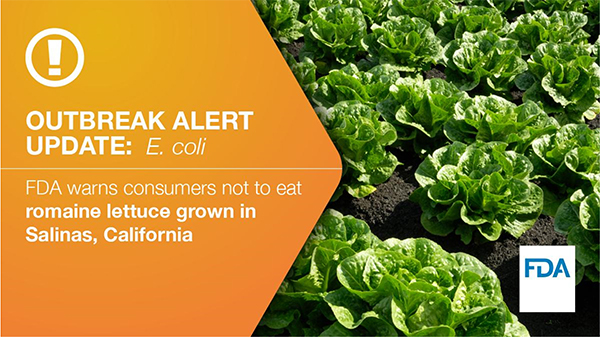From the Food and Drug Administration November 22, 2019:
“Today, we are providing an important update into our investigation of an outbreak of E. coli O157:H7 illnesses which have sickened more than 40 people in 16 states. Our investigation has led us to farms in Salinas, California and while the FDA is sending investigators there to look for the source of contamination, we are updating our advice today to help protect the public health and to help ensure we contain this outbreak. Consumers should not eat any romaine lettuce harvested from Salinas, California. If romaine lettuce does not have labeling information for its growing area or the source cannot be confirmed, consumers should not eat or use the romaine. Restaurants and retailers should not serve or sell romaine lettuce if they cannot confirm it is from outside Salinas. Suppliers, distributors and other supply chain partners should also not sell or ship any romaine lettuce from Salinas. At this time, there is no recommendation for consumers or retailers to avoid using romaine harvested from other sources outside of Salinas or labeled as indoor, or hydroponically- and greenhouse-grown,” said Deputy Commissioner for Food Policy and Response Frank Yiannas.
“Through DNA-fingerprinting, we have been able to associate this outbreak with past outbreaks. Any outbreak is a tragedy and everyone across the supply chain must do more to protect consumers. The lessons we have learned from previous romaine-linked outbreaks and the adoption of labeling and traceability best practices by many in the industry have facilitated our traceback efforts and helped us target our advice to a defined harvest region. Our goal with today’s advice is to limit exposure and help prevent additional people from becoming sick. But once again, this investigation also reinforces our recommendations that we have made to the leafy green industry: producers must continue to review their practices and all segments of the supply chain must improve traceability to enhance food safety. The FDA remains committed to improving the safety of leafy greens and traceability from farm to fork.”
The U.S Food and Drug Administration, the U.S. Centers for Disease Control and Prevention and state health authorities are investigating an outbreak of illnesses caused by E. coli O157:H7 in the U.S. Epidemiologic, laboratory and traceback evidence indicates that romaine lettuce from the Salinas, California growing region is a likely source of this outbreak.
Consumers:
Consumers should not eat romaine lettuce harvested from Salinas, California. Additionally, consumers should not eat products identified in the recall announced by the USDA on November 21, 2019.
Romaine lettuce may be voluntarily labeled with a harvest region. If romaine lettuce has “Salinas” on the label in any form (whether alone or with the name of another location) do not eat it. Throw it away or return it to the place of purchase. If romaine lettuce does not have information about harvest region or does not indicate that it has been grown indoors (i.e., hydroponically- and greenhouse-grown), throw it away or return it to the place of purchase. Consumers ordering salad containing romaine at a restaurant or at a salad bar should ask the staff whether the romaine came from Salinas. If it did, or they do not know, do not eat it.
At this time, romaine lettuce that was harvested outside of the Salinas region has not been implicated in this outbreak investigation. Hydroponically- and greenhouse-grown romaine, which is voluntarily labeled as “indoor grown,” from any region does not appear to be related to the current outbreak. There is no recommendation for consumers to avoid using romaine harvested from these other sources.
Restaurants and Retailers:
Restaurants and retailers should not serve or sell romaine harvested from Salinas, California. If you do not know the source of your romaine lettuce, and if you cannot obtain that information from your supplier, you should not serve, nor sell it.
Suppliers and Distributors:
Suppliers, distributors and others in the supply chain should not ship or sell romaine harvested in Salinas, California. If the source of the romaine lettuce is unknown, you should not ship, nor sell the product.
For Restaurants, Retailers, Suppliers and Distributors:
Currently, the FDA does not have enough traceback information to identify the specific source of the contamination that would allow us to request a targeted recall from specific growers. At this stage in the investigation, the most efficient way to ensure that contaminated romaine is off the market would be for industry to voluntarily withdraw product grown in Salinas, and to withhold distribution of Salinas romaine for the remainder of the growing season in Salinas. The FDA has made this request of industry.
The Salinas region as defined by the United Fresh Produce Association and the Produce Marketing Association Romaine Taskforce Report includes: Santa Cruz, Santa Clara, San Benito and Monterey counties in California.
Genetic analysis of the E. coli O157:H7 strains from patients in this current outbreak are similar to strains of E. coli O157:H7 associated with a previous outbreak from the fall of 2017 and the fall of 2018 that affected consumers in both Canada and the U.S. The 2017 outbreak of E. coli O157:H7 was associated with leafy greens in the U.S. and romaine in Canada. The 2018 outbreak of E. coli O157:H7 was associated with romaine in both countries.
Updated Case Counts:
Total Illnesses: 40
Hospitalizations: 28
Deaths: 0
Last illness onset: November 10, 2019
States with Cases: AZ (2), CA (4), CO (1), ID (3), IL (1), MD (3), MI (1), MN (1), MT (1), NJ (1), NM (2), OH (5), PA (3), VA (1), WA (1), WI (10)



